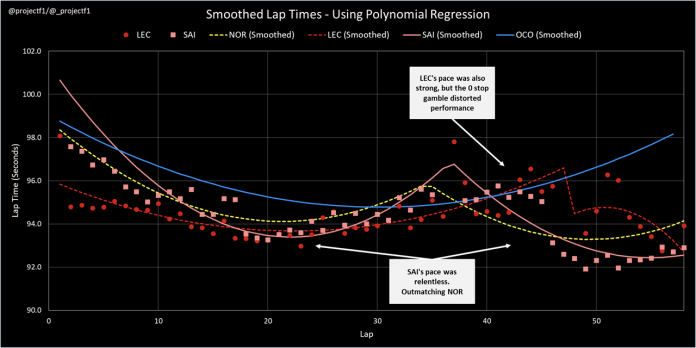The F1 Turkish Grand Prix had all the elements of a potential nail-biting race. Lewis Hamilton was set to fight through the field after incurring a grid penalty for switching to a newer and more powerful engine. While Mercedes teammate Valtteri Bottas had to fend off the double Red Bull threat of Max Verstappen and Sergio Perez. All against the backdrop of changeable track conditions due to a cold and wet circuit.
And though anticipation was high, the excitement unravelled like a typical Shakespearean tragedy. The wet conditions were unyielding and didn’t introduce the typical strategic or overtaking mayhem of wet races in the past. Instead, the race was one of remaining patient and resisting temptation. Which drivers were the most virtuous? Let’s jump into it.
F1-To pit or not to pit? That is the question
The race embarked with little commotion, except for Fernando Alonso who plummeted down the order after a failed but audacious overtaking manoeuvre. Almost instantly the race settled into a calm rhythm of tyre and pace management as showcased in the first half of Figure 1. Why? The weather and track conditions invited uncertainty. A dry line was stubbornly not appearing and the rain continued to remain tentative. Rather than conditions improving or deteriorating in any obvious manner, they simply stayed in a narrow range. As such it became a game of patience; waiting for the right opportunity to make a decision.
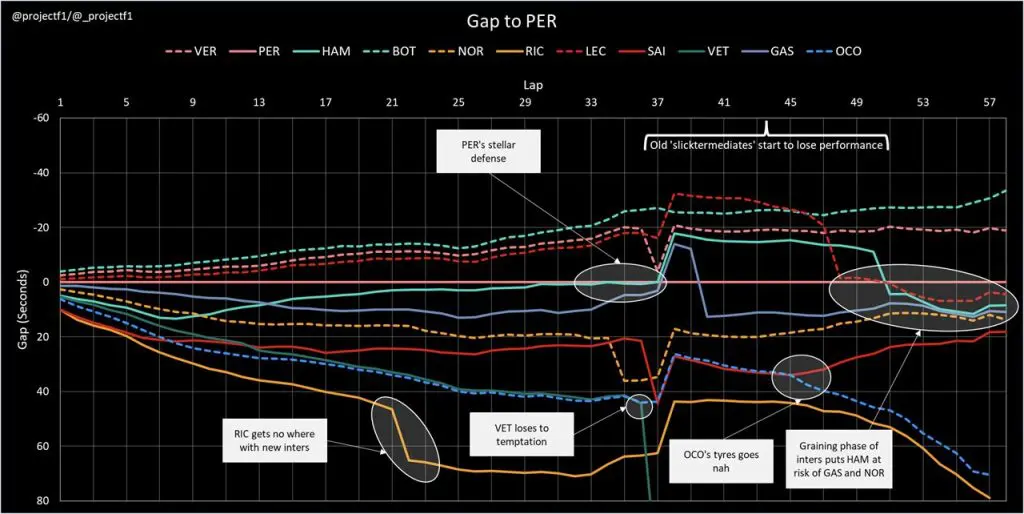
But that opportunity never came, at least not in an obvious sense. So something had to give. McLaren was the first to blink with Daniel Ricciardo. The Australian pitted for a fresh set of intermediate tyres on lap 21. However, Ricciardo’s pace was no better than the others and only fell further behind. The next to give into temptation was Sebastian Vettel who went for the audacious gamble of medium tyres. The car was instantly undrivable as highlighted by the steep drop-off in Figure 1.
So what now? There were 3 ways forward:
- Pit for a new set of intermediates and comfortably make it to the end of the race while minimising the chance for rain-induced error or;
- Stay out and pit for a set of slick tyres but running the risk of the conditions never improving enough for a slick tyre and/or not having enough laps in the race to capitalise on the opportunity. All while still risking a drop-off in tyre performance/complete failure or;
- Commit to not pitting at all with the upshot of gaining a pitstop worth of time on your opponents while running the risk of tyre drop-off, failure or errors.
Picking the right strategy is a contest of risk vs reward as well as trust between pitwall and driver. So how did it play out?
Charles Leclerc is an important character for the overall plot. The Monegasque driver qualified well (P3) and had tremendous pace throughout the whole race. Figure 1 highlights how he was able to keep up with the frontrunners which Figure 2 shows his dominant performance against Lando Norris’ McLaren as well as teammate Carlos Sainz. However, Figure 2 also shows Leclerc’s dilemma as his pace on the old ‘slicktermediates’ was equal to or better than Sainz’s new intermediates. Bottas pitting soon after Sainz also gave Leclerc the lead of the race. These two factors created an immense temptation for both Ferrari and Leclerc. Would pitting now be a senseless move giving up a potential win?
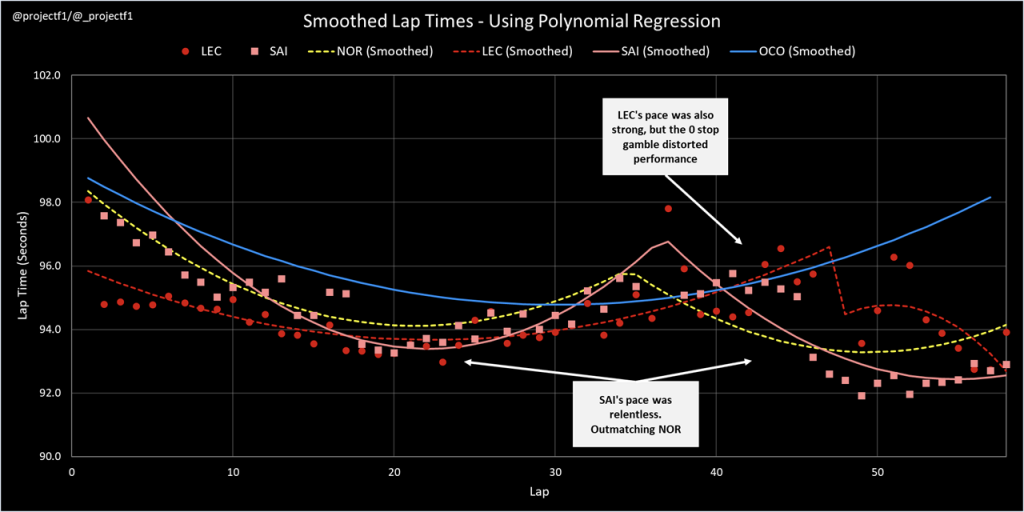
And so the came the decision to execute a 0 stop strategy. Keep in mind that by lap 39 everyone in the top 10 besides Hamilton and Esteban Ocon had pitted. Figure 1 shows that Ocon’s pace was beginning to deteriorate, while Figure 2 shows that Leclerc had superior pace from laps 39 to 42. But mistakes on the next few laps led to a further decline in tyre performance and heat management to the point that Charles was following the same trend as Ocon.
The Ferrari may have been better, but it too would become a casualty of the tyres. Ultimately, Leclerc lost position to Bottas and then swiftly switched tact to limit collateral damage. This would prove to be a fortuitous decision when compared to Hamilton’s plight.
Hamilton was another who found himself in a similar situation to Leclerc. Figure 3 shows that Hamilton’s pace from laps 36 to 45 was on par with championship rival Verstappen despite the Dutchman having a new set of intermediate tyres. And just like the Monegasque driver, Hamilton’s pace was significantly better than Ocon who was starting to suffer a decline in performance. But just as it did for Charles, the tyre performance did begin to decline after lap 45.

And as Leclerc capitulated and conceded the strategy, Hamilton too became a victim of temptation and fell for the red-herring of inheriting P3. After all, Hamilton’s pace didn’t drop off as badly as Leclerc’s, a P3 or better would have been huge for the championship and the W12 was the best car that weekend by a country mile. But Hamilton’s fate followed the same course, only this time leaving the Briton in an uncomfortable no man’s land of the track still not suiting slick tyres and not having enough laps to maximise a new set of intermediates.
Even though Hamilton is known for his tyre management, overtaking and fighting through the field from P11 would have placed more stress on the tyres and contributed to the eventual outcome. Ultimately Lewis had to accept settling for P5 to prevent any further hemorrhaging.
F1-But one thing remains unaddressed: why gamble in the first place?
Let’s analyse the risk and reward trade-off. Leclerc’s upside was a potential race win with the downside of finishing around P4. I’ve excluded the tail risk of a DNF because that is everpresent, albeit higher when risking potential tyre failure. The benefits of the upside are obvious but the downside here really isn’t bad at all. Ferrari comfortably had the measure of their title rival Mclaren and finishing P4 would still result in a favourable points swing. It was arguably a no-lose situation.
Hamilton on the other hand had it all to lose. Hamilton’s upside was a potential P2 and points advantage on Verstappen with a downside of a potential P7. Lewis is subject to the same tail risk caveat. However, it is important to call out that Mercedes had an immense advantage over Red Bull at this circuit. By pitting at a similar time to Max or Perez, uncertainty around the tyre variable is removed and it becomes a straight fight on pace. Bottas had already shown the pace advantage relative to the Red Bulls when all were on the same tyres.
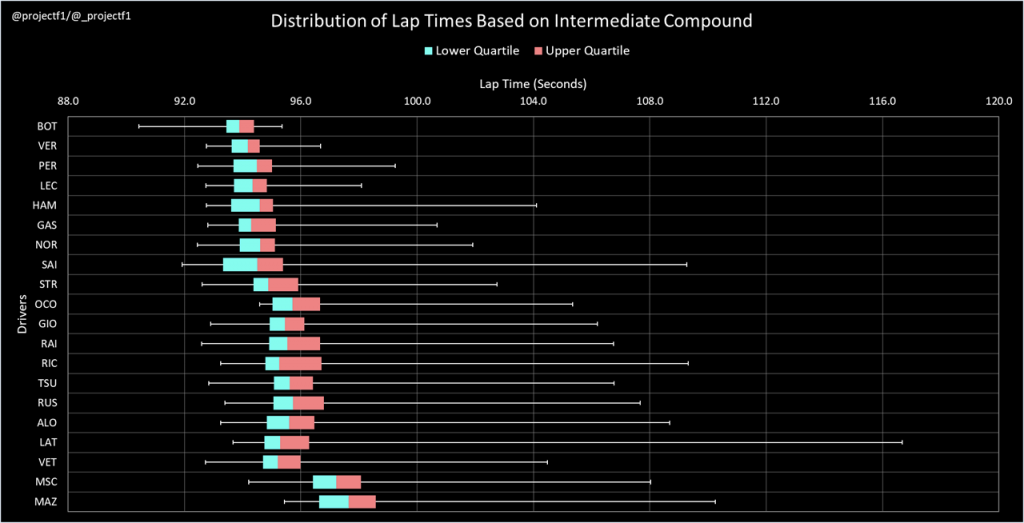
Put another way, there was no need to gamble on tyres when you had the pace advantage. Leclerc did not have this luxury, and hence doesn’t warrant the same critique. Hamilton was also lucky to not lose position to a fast Pierre Gasly, who would have placed ahead if not for his harsh 5-second penalty. These consideration positions the gamble as an unnecessary risk. While the reward could have been sweet, it was simply not worth the risk. And in a championship as tight as this, decisions such as these could prove pivotal.
On the flipside, Ocon was one whose risk-reward trade-off warranted the gamble. Figure 4 showcases the distribution of race pace amongst the field. Ocon’s pace isn’t too different from that of teammate Alonso who spent the entirety of the race struggling to overtake the Williams of George Russell. This was a tell-tale sign of the potential for Ocon to lose position and points to Antonio Giovinazzi who had the better pace. Given this backdrop, an all-in strategy to get points versus a downside of no points seemed like an obvious decision. And it goes without saying, Ocon did an outstanding job being the only driver capable of executing the 0 stop strategy.
F1- Form Favours Ferrari
Mclaren had the headlines at the last two races, but Ferrari had been quietly working away on their next power unit upgrade which has shown a step-change in performance. Leclerc demonstrated this performance in Russia with an impressive drive from the back of the field until another gamble caught the Monegasque driver in undesired territory. This time it was Sainz who cut through the field like a knife in hot butter.
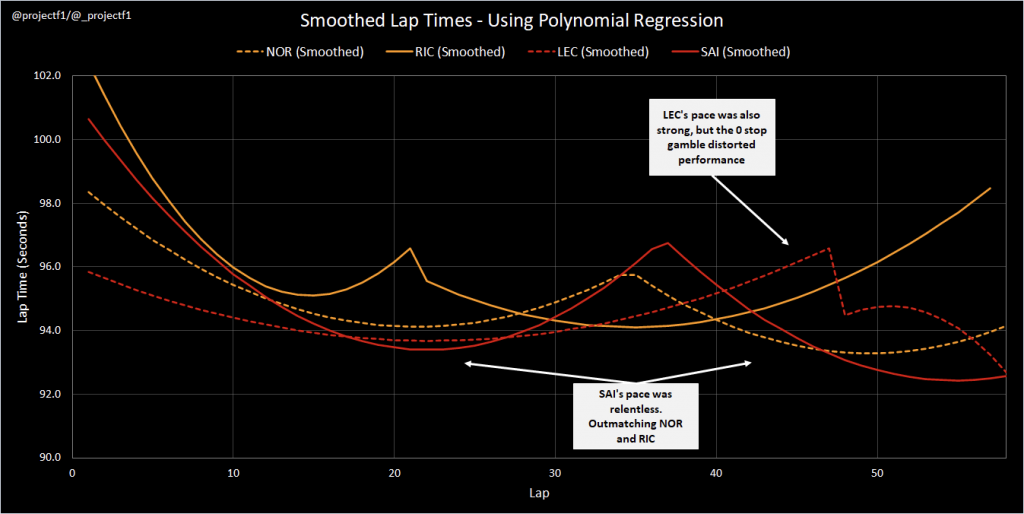
Figure 5 shows the might of both Ferrari drivers that were comfortably ahead of both Mclarens. While Leclerc’s pace is somewhat distorted due to the gamble on the 0 step strategy, Sainz was a clearcut winner compared to Ricciardo who also started at the back with new engine components. The true pace of the Ferrari remains to be seen as both Russia and Turkey were affected by the rain as well as grid penalties. Austin will be the true, unadulterated litmus test.
F1-Second drivers get their second wind
It would be remiss to not applaud the faultless performance that Bottas delivered this weekend. After having one of the worst races of his career last year in Turkey, the Finn dominated every aspect of his drive as Figure 6 highlights that Verstappen was never in a position to challenge for the win. Bottas maximised points for the constructor’s championship while limiting those collected by Verstappen.
In a similar vein, Sergio Perez performed the duties of the second driver to the fullest in a display of astute defensive driving to keep Hamilton at bay and can be seen in Figure 1 earlier. Furthermore, Perez had incredible pace during the second stint as showcased in Figure 7. This was essential in imposing a high degree of pressure upon Hamilton that would eventually invite the strategic misstep.
F1-Watchpoints for the Next Grand Prix
The championship lead has swung again, though perhaps more unexpectedly this time. The next stop is Austin which has been another stomping ground for Hamilton. What will Red Bull be able to muster here before shifting continents again? Only 6 races remain for one of the tightest championships in years. And can Ferrari carry the momentum in their fight against McLaren? Let’s see who survives the pressure.
Author and graphics: Ekagra Gupta – @_ProjectF1

